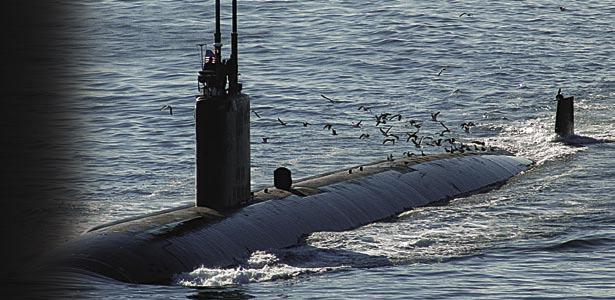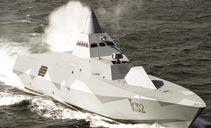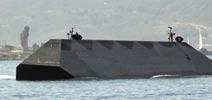
13 minute read
Underwater Stealth: Mine Countermeasures’ Ace in the Hole
Stealth is a game played superbly by the Air Force’s F-117 Nighthawk fighter and B-2 Spirit bomber aircraft in attacking heavily-defended targets. Although these airplanes are not completely invisible to radar at close range, their small detection radii, combined with careful mission planning, allows them to slip through gaps in air defense systems 1 . Some years ago, the U.S. Navy also entered the stealth game with the demonstration ship Sea Shadow 2 , whose technologies are now being incorporated into the design of the DD(X) destroyer and other surface combatants. Stealth technologies reduce ship susceptibility to detection and tracking by acoustic, hydrodynamic, and electromagnetic field sensors, both above and below water. Underwater stealth is especially important in defeating the threat posed by naval influence mines.
Mines are dangerous. Since 1950, naval mines have inflicted three times the number of ship causalities on the U.S. Fleet than all other threats combined 3 . During Operation Desert Storm (1991), USS Tripoli (LPH10) was heavily damaged by an Iraqi contact mine, while an Italian magneticacoustic influence mine, the MANTA, attacked USS Princeton (CG-59) 4 . As recently as Operation Iraqi Freedom (2003), coalition navies were faced with the possibility of a significant naval mineclearing operation, which was obviated when the weapons were captured before they could be deployed by Iraqi forces 5 .
Advertisement
Mines are cheap and can be easily manufactured or bought on the international weapons market. They are difficult and time consuming to find and neutralize, and they can be deployed covertly by an adversary without directly confronting the threat of U.S. naval forces. Casualties from a naval minefield can cost the lives of Sailors, delay or alter the outcome of a conflict, prevent rapid reconstitution of naval capabilities, damage local economies, and adversely influence foreign and domestic politics.
Effective U.S. naval mine-clearing capabilities are a major enabler for the “10-30- 30” war fighting concept established by Defense Secretary Donald H. Rumsfeld 6 . Under his plan, the services would have 10 days to deploy a major force anywhere in the world, 30 days to fight and decisively win the war, and then 30 days to be ready to fight again. Neutralizing a minefield sufficiently to allow forcible entry or strike operations in only 10 to 15 days is a major challenge, even with an armada of underwater, surface, and airborne mine countermeasure (MCM) platforms. A ship casualty caused by a single mine that was missed during clearing operations could adversely impact all phases of the “10-30- 30” strategy.
The Rules
The mine countermeasures game is complicated. The risk of losing a ship or submarine to a mine is very scenario dependent, and it is sensitive to such parameters as: • The density of mines in the field (determined by number and spacing) • The availability of mine hunting and sweeping platforms in theater and their effectiveness in the specific operational environment • Mission plans and their time constraints • The required length and width of safetransit lanes (“Q” routes) and the area needed to conduct operations • The likelihood of friendly combatants to actuate a mine during their transit through the field • The vulnerability of friendly vessels to damage from a detonation
Although the absolute effectiveness of mine-clearing operations and their impact on the overall mission depends heavily on these factors, the general relationship of combatant losses to MCM tactics and technologies has a well-defined character irrespective of scenario details.
Off board MCM systems are very effective in detecting and neutralizing mines moored in the water column, especially in comparison to their performance against bottom mines. In addition, onboard mine hunting sonar equipment is being developed that can quickly and reliably detect moored contact mines with sufficient warning time to allow a naval vessel to avoid them. In contrast, the buried or partially-buried multi-influence bottom mine is a very imposing threat and difficult to defend against.
Naval combatant susceptibility to bottom influence mines has a parabolic dependence on the level of MCM effort expended before the first attempt to transit the field. Figure 1 shows hypothetical examples of this parabolic relationship for dense, medium-dense, and sparse minefields. The horizontal axis represents the amount of MCM effort measured in platform-days, that is, the sum of the number of days each MCM platform (helicopters, unmanned underwater and surface vehicles, etc.) devotes to the clearance operation. Although the absolute scales on the axes of the graph

and the relative vertical separation between the three curves will depend on specific scenarios, the trends shown in the figure apply to any minefield.
The MCM “Game Strategy”
All good defenses are layered, and MCM is no exception. The first and best defense against mines is to prevent their manufacture, transport, and deployment. But because of tactical or political constraints, many of them will slip through and be deployed against U.S. and allied vessels. The second defensive layer includes detecting mines by hunting, destroying them with explosive charges, and decoying them with influence sweeping. However, there is always a chance that one or two will be missed due to mission time constraints, unfavorable environmental conditions, equipment malfunctions, operator error, or poor planning. The final burden of defense then falls on underwater signature stealth, to hide a vessel from attack by a mine or to blind it with a jamming signal.
The MCM effectiveness curves show several important characteristics of mineclearing operations that can be used to plan a strong defensive strategy. First, the time constraints of the “10-30-30” warfighting concept will limit the best possible MCM effort to some maximum value. As demonstrated by the vertical line in Figure 1, the risk to combatants would then vary depending on the density of the mines
U.S. Navy photo
encountered. The first and best MCM strategy is to prevent mines from being laid, or to keep a sparse minefield from becoming dense by denying enemy forces the opportunity to deploy the weapons. Losing a ship to a minefield or accepting casualties to its crew is unacceptable. The sinking of a single naval platform or its receiving mission-abort damage could easily extend the conflict beyond the 30 day war-fighting phase of “10-30-30”, and could also delay the second 30 day phase of preparing for the next war. Therefore, a low to very-low risk level is required for transiting combatants. The intersection of the horizontal line in Figure 1 with the asymptotic portion of the effectiveness curves shows that to achieve a low-risk condition could require a significant, or even unachievable, MCM time-line, depending on the mine density. The diminishing returns of the MCM effectiveness curves (flattening at higher levels of MCM effort) are caused by the resource-intensive process of removing the last one or two mines from the field; a characteristic of all mineclearing scenarios. It takes only one missed $10,000 mine to sink a $2 billion ship.
Playing the Ace
Underwater stealth for ships is achieved through the application of signaturereduction technologies. Influence mines actuate on the mechanical or electromagnetic energy generated by a ship or
submarine’s hull, machinery, or electrical equipment. Ships and ship systems generate acoustic and seismic signatures, hydrodynamic (pressure) signals, static magnetic and electric fields, and electromagnetic (alternating electric and magnetic) fields. An influence mine’s firing logic combines outputs from its sensors to: • Reduce environmental background noise • Classify the target • Localize the target to maximize lethality of the attack • Identify and reject signals from minesweeping systems or other false target sources.
Minimizing a naval vessel’s underwater signatures makes each of these four tasks much more difficult for the mine, and sufficient stealth can actually render it ineffective.

The Swedish Visby-class corvette is a composite hull (carbon fiber reinforced plastic) combatant that has both above and underwater stealth design features. The design of the Visby minimizes the optical and infrared signature, above water acoustic and hydroacoustic signature, underwater electrical potential and magnetic signature, pressure signature, radar cross section, and actively emitted signals.
Like stealth aircraft flying against an air defense system, reducing underwater signatures can shorten an influence mine’s actuation radius to the point where it is no longer a threat. For example, water depths deeper than a bottom mine’s attack range need not be immediately cleared, along with the buffer zones along the edges of transit lanes and maneuvering areas. In addition, vessels employing underwater stealth technologies would have a reduced probability of actuating any residual mines that might have been left after clearing.
Decreasing the attack radii of deployed influence mines is analogous to reducing the effective density of the field. For example, if 100 mines have been deployed in an area but only 25 can detect the transiting targets due to the latter’s low signatures, then the effective density of the field has been reduced by 75 percent. As shown by the parabolic mine-clearing curves in Figure 2, underwater signature mitigation can reduce the effective mine density, and improve the efficiency of MCM operations by lowering the time needed to achieve a low risk condition significantly. Eventually, all mines will have to be removed from the field before naval and commercial ships not equipped with stealth technologies can transit the area, but this can be accomplished after the time-constrained forcedentry or strike phase of the operation has been completed.
A second way underwater stealth improves MCM effectiveness is to increase the efficiency of minesweeping. The firing thresholds of mines are typically set so that for actuation, the target needs to be close enough for a detonation to result in a high kill probability. Depending on the scenario, setting the firing threshold too high – requiring a larger signature – could result in a catastrophic failure of the minefield, allowing all ships to pass safely. But if ship signatures are reduced and the minefield planner does not likewise lower his actuation thresholds, then the firing radius of his mines will be smaller. On the other hand, if the minefield planner decreases the actuation thresholds to maintain the same damage radii with quieter ship signatures, the more sensitive firing criteria will make the mines easier to sweep. In either case the risk to transiting ships is reduced, and can be viewed once again as equivalent to lowering of the mine density curves of Figure 2.
An ace in the hole does not guarantee a winning hand, especially if it is played poorly. It has also been suggested that artificially enhancing the amplitude of a vessel’s underwater signatures would reduce the threat of influence mines by causing them to detonate while the target is still outside the warhead’s damage range. However, the firing logic found in modern multi-influence weapons easily prevents this from occurring. Thus, deliberate signature amplification would raise the effective density of the field by increasing the actuation ranges and threat from those mines that were previously rendered ineffective using underwater stealth techniques, while providing little protection to follow-on traffic (see Figure 3). Risking a $2 billion manned combatant to sweep a minefield instead of a helicopter or unmanned surface vehicle is not a good bet.
Ironically, a submarine, the quintessential stealth naval vessel, cannot use all the mine-clearing tools available to surface ships. To remain undetected, pre-cursor sweeping before transiting a minefield is
(left to right) Fig. 1 Mine countermeasure effectiveness and the relationship between combatant risk and mine-clearing effort.
Fig. 2 The impact of underwater stealth on mine-clearing effectiveness.
Fig. 3 The impact of deliberate signature amplification on risk of loosing a combatant.
Fig. 4 The impact of omitting sweeping from submarine mine-clearing operations.
generally not an option for submarines. Even if unmanned underwater sweep systems were available, their successful use in detonating mines would immediately give away a submarine’s approximate location or reveal its intended lane of transit. A submarine must rely solely on hunting mines, avoiding them, and if necessary, covert – non-explosive – neutralization.
Removing sweeping from the submarine’s mine-clearing toolbox raises the minefield’s effective density in comparison to an equivalent surface ship scenario. For the reasons discussed, all mines may not be detected during hunting operations. In addition, losing the benefit of pre-cursor sweeping increases the mine hunting timeline necessary to reduce the submarine’s risk to an acceptable level. Therefore, more mines will remain in the field – yielding a higher effective density – for a submarine, hunting-only scenario than in the equivalent case for surface ships that includes sweeping (Figure 4) As a result, a submarine requires more underwater stealth and higher levels of signature reduction than a surface ship to survive similar types of minefields.
Stacking the Deck
Unlike poker, warfare is not a game that needs to be played fairly. The lives of Sailors and the wellbeing of the nation are at stake. Overwhelming military force must be used to win conflicts quickly and within the clearly defined “10-30-30” time constraints. Underwater stealth can enable combatants to achieve surprise and conduct their strike-warfare missions quickly and with low risk of mine damage, even with minimal MCM efforts.
New signature reduction technologies could make naval combatants as invulnerable to mine threats as the F-117 fighter and B-2 bomber are to air defenses. However, as with aircraft, achieving stealth must be a primary design objective from the very beginning, because incorporating the means to quiet underwater signatures cannot be an afterthought while building ships and submarines.
All aspects of mechanical and electrical ship systems must be considered in designing a vessel with quiet underwater signatures. These include hull shape and internal structure, material properties, propulsion and auxiliary machinery, electrical systems, payloads, sensors, and active signature-compensation systems. A true stealth ship would have a very small mine risk curve similar to that shown in Figure 5. Like its more familiar aircraft counterparts, the stealth ship may not be completely invisible to influence mines at extremely close ranges; but combined with careful mission planning, it could slip in and out of minefields with near impunity. The design and construction of a strikecapable “Underwater Stealth Ship” would benefit U.S. naval warfare in several ways. First, a squadron of these combatants could be used against objectives that are heavily defended by mines with the same military advantages realized by stealth aircraft against robust air defenses. Second, all the aspects of a vessel’s structure, systems, and individual components that contribute to its underwater signatures would be identified, their relative importance quantified, and silencing methods developed. Simple and inexpensive changes to designs could be immediately incorporated into new construction. Also, the development of new technologies to provide revolutionary, low signature levels would be accelerated

The Sea Shadow program began in the mid-1980s. Its purpose is to explore a variety of new technologies for surface ships, including ship control, structures, automation for reduced manning, seakeeping and signature control.
in the process. Incorporation of these new technologies into the design of all future naval vessels could then concentrate on reducing system costs and ship impact. The force-multiplying payoffs and the technology development process of the F-117 and B-2 aircraft exemplify the right way to play the game of underwater stealth.
Dr. Holmes is a Senior Scientist in the Underwater Electromagnetic Signature & Technology Division (CODE 75) in the Carderock Division of the Naval Surface Warfare Center in West Bethesda, Md.
References
1. Day, Dwayne A., “Stealth Technology”, U.S. Centennial of Flight., U.S. Centennial of Flight Commission, 18 July 2005, <http://www.centennialofflight. gov/essay/Evolution_of_Technology/Stealth_tech/Tech18. htm>. 2. “Sea Shadow” United States Navy Fact File, 24 May 1999, Naval Sea Systems Command, 18 July 2005, <http:// www.chinfo.navy.mil/navpalib/factfile/ships/ship-sea.html>. 3. “U.S. Navy Marine Mammal Mine Hunting System” U.S. Navy Marine Mammal Program, Space and Naval Warfare Systems Command, 18 July 2005, <http://www. spawar.navy.mil/sandiego/technology/mammals/mine_hunting.html>. 4. Szpyrka, Rick, “Interesting MSO Facts,” The Chain Locker, Navy MSO Organization, 18 July 2005, <http:// www.minesweep.org/msofacts.htm>. 5. “Operation: Iraqi Freedom.” Naval Explosive Ordnance Disposal Technology Division, Naval Sea Systems Command, 18 July 2005, <https://naveodtechdiv.navsea. navy.mil/OIF/photos/default.asp>. 6. Barnard, Richard C. “Sea Basing Concept Promises a Revolution in Power Projection” Sea Power, June 2004.







